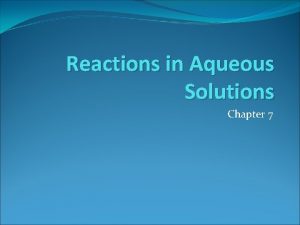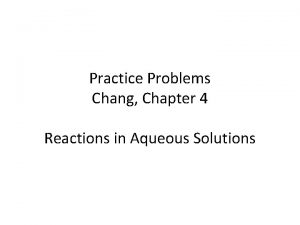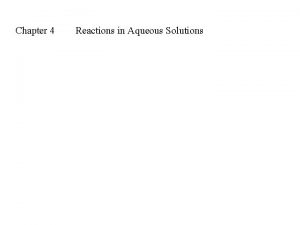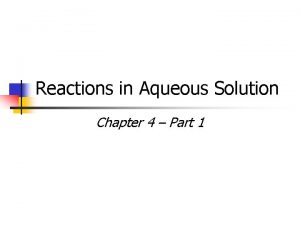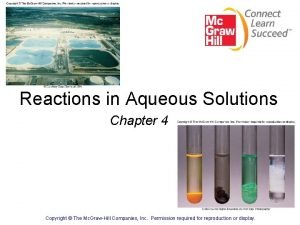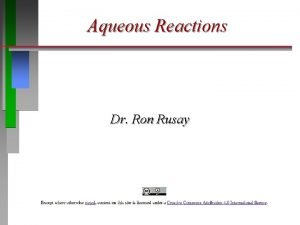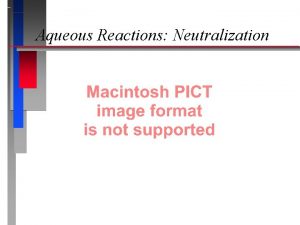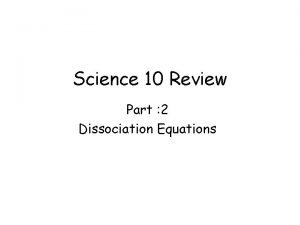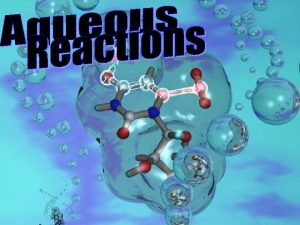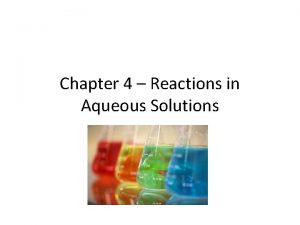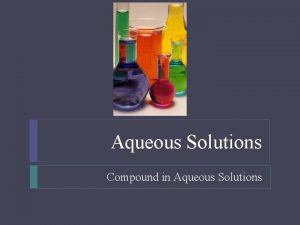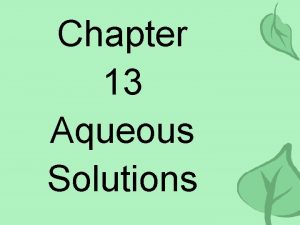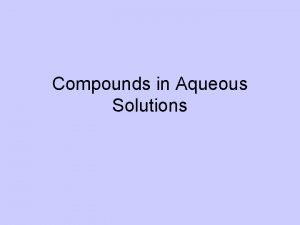Reactions in Solutions Dissociation Equations In aqueous solutions











- Slides: 11

Reactions in Solutions

Dissociation Equations In aqueous solutions, highly soluble ionic compounds dissociate into their ions. E. g. Sr(NO 3)2(s) → Sr 2+(aq) + 2 NO 3 -(aq)

Reactions in Solution • When combining two aqueous ionic solutions there are two possible outcomes: 1. The solutions do not react and remain in solution 2. The solutions react (double displacement) forming either – A gas – A precipitate – Water

Reactions Producing a Gas Remember your gas tests? • Oxygen • Hydrogen • Carbon dioxide

Precipitation Reactions • Double displacement reactions involve aqueous solutions of ionic compounds • For a reaction to occur, a precipitate (insoluble solid) must form • To predict which ionic compounds will be soluble, and which will form precipitates (insoluble) we must use the solubility rules: 1. All compounds with nitrate (NO 3 -) are soluble 2. All compounds with ammonium (NH 4+) are soluble 3. All compounds with group 1 metals are soluble 4. Most other compounds are insoluble (will form a precipitate)

General Solubility Guidelines Guideline 1 2 Cation Anion Result Exceptions Soluble Ca(Cl. O 3)2 is insoluble CO 32 -, PO 43 -, O 2 S 2 -, OH- Insoluble Ba. O and Ba(OH)2 are soluble. Group 2 sulfides decompose Cl-, Br-, I- Soluble Li+, Na+, K+, NO 3 -, Rb+, Cs+, Cl. O 3 -, NH 4+ CH 3 COOAg+, Pb 2+, Hg+ 3 4 Ba 2+, Ca 2+, Sr 2+ 5 Mg 2+, Cu 2+, Zn 2+, Fe 3+, Al 3+ Insoluble SO 42 - Soluble

• Ba. Cl 2 is a white crystalline powder. Is it soluble or insoluble? • The Ba 2+ ion is insoluble. It is in guideline 4. • The Cl- ion is soluble. It is listed in guidelie 3. • The higher the guideline number takes precedence. • Ba. Cl 2 is soluble.

Pb(NO 3)(aq) + 2 KI(aq) Pb. I 2 + 2 K(NO 3) • Pb 2+ is guideline 2, insoluble • I- is guideline 3, soluble » These two together make an insoluble compound because of the lead is higher and insoluble. • K+ is guideline 1, soluble • (NO 3)- is guideline 1, soluble » These two together make a soluble compound because they are both soluble!

Practice Will the following solutions produce a precipitate? A. potassium carbonate and copper (I) sulfate B. ammonium chloride and sodium sulfate C. sodium carbonate and barium nitrate D. lithium hydroxide and ammonium chlorate

Reactions Producing Water • Neutralization reactions • Acid + base ➔ salt + water • p. H tests (litmus paper, phenolphthalein, bromothymol blue, universal indicator)

Practice • p. 332 #1, 2 • p. 138 -143 #1 -5, 7
 Types of reactions
Types of reactions Reactions in aqueous solutions
Reactions in aqueous solutions Calculate the number of grams of al in 371g of al2o3
Calculate the number of grams of al in 371g of al2o3 Chapter 4 reactions in aqueous solutions
Chapter 4 reactions in aqueous solutions Concentrated solution
Concentrated solution Chapter 4 reactions in aqueous solutions worksheet answers
Chapter 4 reactions in aqueous solutions worksheet answers Dilute solution
Dilute solution Aqueous reactions and solution stoichiometry
Aqueous reactions and solution stoichiometry Section 2 classifying chemical reactions
Section 2 classifying chemical reactions Balancing redox reactions in acidic solution
Balancing redox reactions in acidic solution Section 2 reinforcement classifying chemical reactions
Section 2 reinforcement classifying chemical reactions Unit 5 chemical reactions answers
Unit 5 chemical reactions answers

